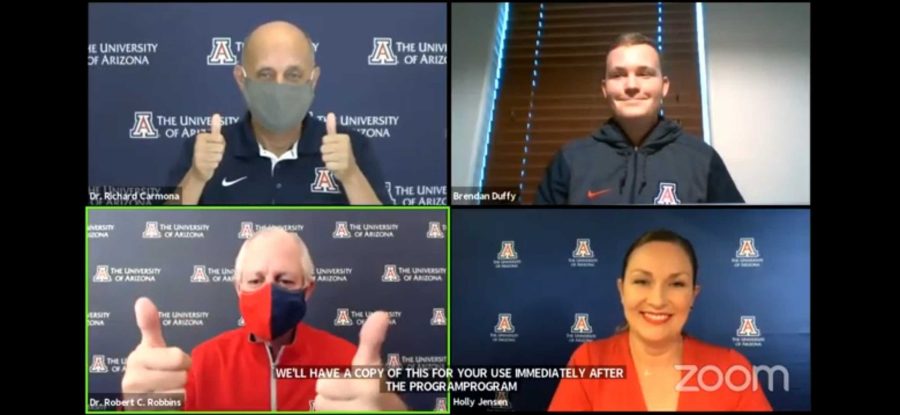At Monday’s reentry briefing, University of Arizona President Dr. Robert C. Robbins announced another extension of in-person instruction for only Phase 1 courses and discussed stronger disciplinary measures for students who are not following the university’s rules related to COVID-19.
The university experienced a dramatic spike in COVID-19 cases resulting in a shelter-in-place recommendation issued at the Sept. 14 briefing. The spike took the university to a 10-12% positive rate of tests, which has since dropped back to 6.1% as of Sept. 18, according to Robbins.
“That’s clearly down,” Robbins said. “We want to get under that 5% level.”
The university almost reached capacity in its isolation beds, which surpassed the originally planned 400 spots. However, the capacity was increased to 600 beds, and currently 324 are occupied, according to Vice President of Communications Holly Jenkins. An additional 75 students are quarantined off campus, whether in their homes, hotels or Airbnbs, according to Robbins.
As a result of increasing COVID-19 cases and campus outbreaks, Robbins has increased the length of the first phase of reentry twice over. This week he extended Phase 1 through the week of Sept. 28.
“We try to make that announcement every week here at the press briefing,” Robbins said. “This is out of an abundance of caution.”
Phase 1 includes in-person classes only for lab-, research- and performance-based courses, which, according to Robbins, means approximately 5,000 students are currently attending courses on campus.
Robbins also said the UA continues to see “compliance issues” with a minority of the student population.
“This past weekend — I think it was Thursday night or Friday — a large party with over 300 attendees was discovered and was dispersed,” Robbins said. “This resulted in several student sanctions. This kind of behavior will negatively affect everyone.”
Robbins said parties from Thursday, Sept. 18, to Saturday, Sept. 20, were cited on 17 properties, with 10 red tags issued and 19 citations, as well as 25 Code of Conduct violations. He said they were no longer “begging” students to follow the rules but are now going to take further action on student behavior.
“When we started this, we communicated very clearly that we knew we could stand up this campus to be resilient, to mitigate infection, the physical plan has been ready,” said Reentry Task Force Director Dr. Richard Carmona. “We also recognized that our Achilles heel was going to be the social behavior — the normal social behaviors — of young men and women who come to college.”
Carmona explained that while transmissibility in Arizona is relatively low at approximately 1, around the UA’s zip code (85719), transmissibility is at 2.5, meaning for every one COVID-19 case, on average over two other people will be infected.
From the very first in the series of reentry briefings, Robbins and Carmona have spoken on the importance of student ambassadors to encourage students to follow the UA’s guidelines. Brendan Duffy, a member of the “CAT” team of COVID-19 ambassadors, joined the meeting to speak on some of the work the team does on a daily basis.
Duffy said the “CAT” team, which includes over 25 students, uses three golf carts as well as members on foot to remind people to wear their masks and physically distance. The group has also begun assisting with UA-administered COVID-19 tests and is in the process of setting up a call center for UA COVID-19 information.
“I think the majority of students, probably even at those parties, are excited to, you know, eventually have the opportunity to be back in the classroom,” Duffy said.
Robbins and Carmona both warned of more harsh consequences, including expulsion, for students who continue to break the university’s rules on public health and safety.
Robbins asked students to follow the guidelines put in place on campus, saying students should wear their masks, physically distance, get tested regularly, cooperate with contact tracing and isolate should they get the disease.
“What we’re really asking people to do with this quarantine [or shelter-in-place] is go to work, go to class for the essential courses, even go the library, go pick up dinner if you need to, but don’t congregate in large groups,” Robbins said.
While the shelter-in-place recommendation was not legally enforced, Carmona said there was a potential the UA would need to consult Pima County to place buildings under legally binding quarantines.
“If there is a surge again, … we don’t have much left in our toolbox except a legal quarantine,” Carmona said.
To view the full reentry briefing, visit the UA’s YouTube channel.
Follow Sam Burdette on Twitter









